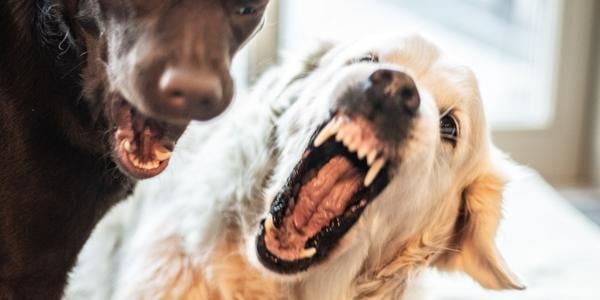 Dog fights can be very scary when they happen. Our usual instinct is to scream and run into the fight hands-first to pull the dogs apart. But doing so could lead to severe injuries to both yourself or further injury to the dogs involved.
Dog fights can be very scary when they happen. Our usual instinct is to scream and run into the fight hands-first to pull the dogs apart. But doing so could lead to severe injuries to both yourself or further injury to the dogs involved.
Every dog owner should know how to break up a dog fight in a way that is not only safer for them but also will help prevent worse injuries to a dog.
Having broken up a variety of dog fights in my career, I can tell you that planning for it ahead of time makes it easier to focus the adrenaline rush into fast and efficient separation.
I've had many training clients contact me after breaking up a dog fight for help with their dog's aggression, many with injuries to hands or arms. The techniques for breaking up a dog fight below are designed to prevent these injuries.
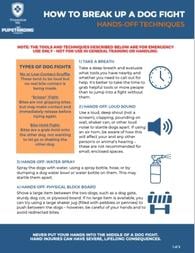 Download a printable flyer of the steps for breaking up a dog fight. Share this infographic or post it in your facility! Simply fill out this form for instant download access:
Download a printable flyer of the steps for breaking up a dog fight. Share this infographic or post it in your facility! Simply fill out this form for instant download access:
The 3 Types of Dog Fights
The type of dog fight will determine how you can stop it as quickly and safely as possible. I'm grouping dog fights into three different types further below, but be aware that a fight can shift from one to another if not stopped.
Fights can happen between dogs who share the same home (intrahousehold aggression), unfamiliar dogs at the dog park, at dog daycares, shelters, or off-leash dogs towards leashed dogs, and more. There are many reasons dog fights happen. In most cases, dog fights start over a resource, such as food, treats, toys, or people. It's important to address resource guarding in dogs as early as possible. In other instances, a dog fight may start when a dog ignores or doesn't understand another dog's communication that they want to be left alone, which can happen when a dog missed out on early socialization.
No to Low-Contact 'Scuffle'
These fights tend to be loud with lots of snarling, growling, and barking. What's "good" here is that if a dog is able to make a lot of noise, that usually means their mouth isn't full of the other dog. In these scuffles, there is little to no actual bite contact. Typically these fights can be stopped by using hands-off techniques.
Bite-Release 'Scissor' Fight
This type of dog fight includes bite attempts, but not grab-and-hold biting. There may be bite contact, but the dog releases and does not hold on before trying again. For stopping these fights, you should start with hands-off techniques but may need to move quickly to hands-on separation options.
Bite-Hold 'Grab' Fight
These are the most severe of dog fights, where the dog(s) are biting and holding onto the other dog. They may bite and hold or shake the other dog. While there may be growling, these fights tend to be quieter than the other two types, since the dogs' mouths are busy. Stopping these fights usually requires going straight to high-level hands-on techniques with the help of at least one other person.
How to Break Up a Dog Fight: Hands-Off Techniques
Some of the tools mentioned below are aversives (adding something unpleasant or painful to make a behavior stop). These are not for use in dog training or behavior modification for reasons explained in this article on aversive use. Only use these tools in case of emergency after a dog fight has started.
If a dog fight breaks out, follow the steps outlined below. No matter the type of fight, it's crucial to immediately separate the dogs in their own secure area to allow for evaluation and decompression. Longer-term separation may be required in some cases. It's best to connect with a certified canine behavior consultant for help determining why fights between dogs are happening and how you can address it.
 1. Evaluate and Take a Breath
1. Evaluate and Take a Breath
If a dog fight starts, it's crucial to first take a breath and plan you're next move. Evaluate what type of dog fight it is, as that may mean you go straight to hands-on techniques versus starting with hands-off (and therefore safer) ways to break up the dogs. Look for what tools are nearby that can help you separate the dogs, and consider whether you need to call out for help from someone nearby.
There is usually time to grab tools or other props to help break up the fight or get help from someone. However, there are two cases in which time is of the essence in separating the dogs — when there are significant size differences between the fighting dogs (large dog vs. small dog) or when a dog has a gripping bite on another dog's airway or major blood supply.
 2. Make a Loud Sound
2. Make a Loud Sound
Use a loud, deep shout (not a scream), clapping, pounding on the wall, or other loud noise to attempt to startle the dogs apart. Other sound options include an air horn, a shaker can/jug, a can of compressed air, or banging pots or pans together.
A shaker can or jug is simply a closed container with a few pebbles or coins inside that you can shake to make noise. This could be a soda can or a plastic milk jug. Compressed air may not be loud enough to startle dogs apart, especially if the fight is loud. If using an air horn, be aware of how this will affect your and any other person's or animal's hearing – these are not recommended for small, enclosed spaces.
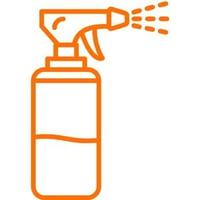 3. Water Spray
3. Water Spray
Spray the dogs with water, using a spray bottle or water hose, or by dumping water from a dog water bowl or water bottle on them. This may startle them apart.
If using a spray bottle, make sure it has a stream setting and a good range. "Misting" the dogs likely won't do much.
 4. Physical Block Board
4. Physical Block Board
Shove a large item between the two fighting dogs, such as a dog gate, sturdy dog cot, chair, trash can, or plywood board. For those who work in shelters or daycares, there are livestock sorting boards (sometimes called "block boards") that are ideal for separating animals as they have built-in handles. Keeping one or two of these on hand for play areas is recommended.
If no large and sturdy item is available, you can try using a large shaker jug (filled with pebbles or pennies) to push between the dogs' faces — however, be careful of where your hands are placed to avoid redirected bites.
Note: If two dogs are "posturing" or threatening each other prior to an actual fight, you can also use a physical block to de-escalate.
Here's a video clip from the Shelter Playgroup Alliance showing how to safely use a block board:
Can You Throw a Blanket on the Dogs to Stop a Fight?
A common recommendation to stop a dog fight is to throw a blanket on top of them. I personally am not a big fan of this option for anything except a no-contact scuffle. Why? Well, if two dogs are fighting a thrown blanket doesn't have a high chance of interrupting them. Then you have two dogs fighting and getting tangled under a blanket and you can't see where their mouths and teeth are, making it less safe for you.
If you do try this option as part of a physical block or startle, just be ready to pull the blanket off quickly before trying a different technique.
How to Break Up a Dog Fight: Hands-On Techniques
 5. Leashed Separation
5. Leashed Separation
Safety Note: Do not use this technique for bite-hold fights as trying to pull the dogs apart could cause worse injury at the bite location.
Use leashes to separate the dogs. If leashes are not already attached to the dog, grab a slip lead and loop it over the dog's neck (this takes some lasso skills) or around their body in front of their hind legs.
If you are alone, pull one dog away and securely attach them to a fence or post before then pulling the other dog away and separating.
This technique has a high risk of redirected bites, where a dog whips around to bite the person when they can no longer get to the other dog. They aren't usually doing this maliciously, as often they simply turn to bite whatever is closest out of frustration or overarousal. Both dog bites I have received in my life have been redirected bites when breaking up a dog fight.
 6. Wheelbarrow Separation
6. Wheelbarrow Separation
Safety Note: Do not use this technique for bite-hold fights as trying to pull the dogs apart could cause worse injury at the bite location.
Two people are required for this technique. If alone, you could attempt if you can securely attach one dog to a fence or post with a leash.
Grab a hold of each dog from directly behind, hands holding the dog at the top and inside of their back things/legs (where the legs meet their body). Lift up like a wheelbarrow and turn dogs away in opposite directions from each other. Gain better control of the dogs with a leash and separate them in different areas.
Here's a video clip showing the wheelbarrow position, explained by the acclaimed Trish McMillan (From the When Sh*t Hits the Fan Webinar).
What Is Control Position?
The next three techniques to break up a dog fight require you to take the "control position." The control position is where you stand straddling the dog's body with your legs, facing the same direction. Your legs should be positioned in front of their hips but behind the ribs. With your hands, firmly grip the back of their neck by the scruff (and collar, if available). Do not only hold them by the collar, as collars can break but scruffs do not.
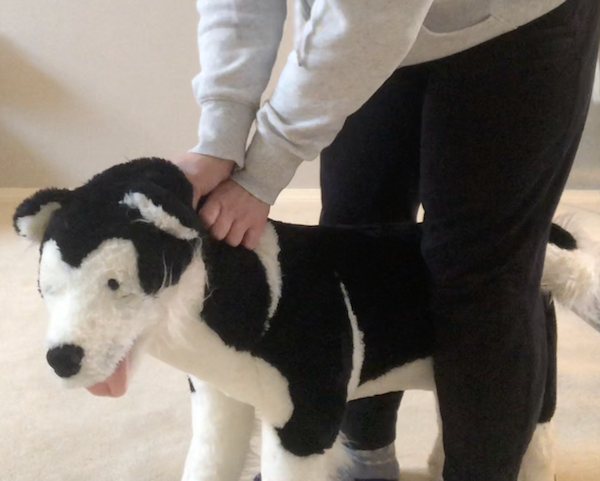
In the control position, you have control over the dog's body with your legs and of their head with your hands. This helps prevent redirected bites to yourself and makes it difficult for a dog to attempt further bites to the other dog once separated.
Alternative control position: For small or very large dogs (or when you are uncomfortable having both legs straddling the dog), you can use an alternative control position. One hand is holding the collar/scruff of the dog, and that arm is locked straight. The other arm can grip the dog on the same side back leg or hock (ankle) of the dog.
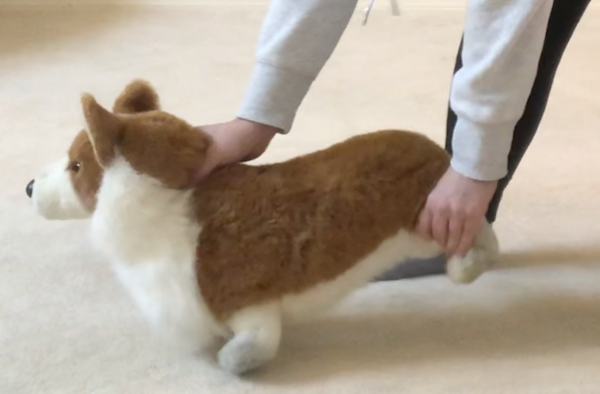
 7. Deterrent Spray to Release
7. Deterrent Spray to Release
For Bite-Hold Fights Only. Assume control position.
Spray citronella spray directly into the nose and mouth of the biting dog. The smell and taste can get them to release their bite. When they release the bite, immediately move the dogs away from each other, staying in control position until they are secured.
 8. "Feed" the Bite
8. "Feed" the Bite
For Bite-Hold Fights Only. Assume control position.
Done ideally with two people (one to control the dog being bitten, and the other to control the biting dog). From the control position, push the biting dog's mouth INTO the bite. Hold the victim dog steady or push them into the bite at the same time. When the bite releases, immediately move the dogs away from each other, staying in control position until they are secured.
This video clip from Shelter Playgroup Alliance shows an example of what this looks like (note that they are in the alternate control position):
This "feeding the bite" technique can also be used by a person being bitten by a dog that won't let go. Push INTO the bite.
 9. Use a Bite Stick ('Break Stick')
9. Use a Bite Stick ('Break Stick')
For Bite-Hold Fights Only. Assume control position.
Insert the pointed end of the bite stick behind the dog's front canine teeth (there is a natural gap here). Do not try to fit it between the back molars, as there simply isn't space. Wiggle it in as much as possible.
Twist the break stick forward or backward, as if you were revving a motorcycle engine, to release the bite. When the mouth opens, immediately move the dogs away from each other, staying in control position until they are secured.
The next two videos (from the When Sh*t Hits the Fan Webinar) explain how to use a break stick as well as an example of it being used during a shelter dog assessment:
Ideally, there are at least two people breaking up the fighting dogs when using a break stick, one to hold the victim dog in the control position, another to hold the aggressing dog in the control position, and to use the break stick. Three people would be even better, where the third person can be the one to use the break stick while the other two control the dogs.
What to Do After a Dog Fight
Immediately separate dogs in their own secure areas. This allows you time to evaluate whether either or both dogs need veterinary care. Any puncture wounds — even small ones — or lacerations in the skin require veterinary care as soon as possible to prevent infection. If the puncture is not bleeding profusely, you are able to flush and bandage it, you may be able to avoid an emergency veterinary visit and instead go to your regular veterinarian for care.
Mild abrasions can be treated at home as long as you follow proper wound care. If the area doesn't begin to show improvement within a couple of days or worsens (becomes painful, swollen, warm, or moist). If the dog appears to be in pain, even with no obvious physical wounds or has issues breathing, seek immediate veterinary care.
If you or any other person has sustained injuries when breaking up a dog fight, seek immediate medical attention — especially if immunocompromised due to the high risk of infection from a dog bite. You need to inform the doctor that the injury was from a dog bite and will need proof of a rabies vaccine for the dog(s) involved.
This initial separation after a dog fight also gives you the time and space to remove items that may have triggered the altercation and consider whether you need to change any management strategies. For low-level scuffles, you may not need to keep the dogs separated for long, especially if you remove an item that they were fighting over. Following more intense fights, allowing time to decompress and for the stress chemical cortisol in their bodies to return to normal levels can be helpful. Be aware of their body language and whether they seem on edge or worried about the presence of the other dog when and if you reintegrate them. If in doubt, keep them separate and connect with a certified canine behavior consultant for support.
Do not punish either dog for fighting. It isn't helpful and the dog will not understand what they are being punished for. In fact, this can actually increase a negative emotional response and higher stress, which can lead to increased aggression and fights in the future.
What NOT to Do When Breaking Up a Dog Fight
Do Not Put Your Hands Directly Into a Dog Fight
Never put your hands in between two fighting dogs. Do not use your hands to try and pry open a dog's jaw. Don't use your legs either. Do not step in between two fighting dogs or use a leg to try and block one dog from the other. Instead, use leashes, blocking boards, or use the control position to safely separate dogs.
Dog bites can cause severe, long-lasting debilitating injuries and/or lead to infection and further complications. Your hands and fingers are very important for day-to-day activities. Losing a finger or suffering nerve damage is something you most certainly want to avoid.
Do Not Kick or Hit the Dogs
You might assume that punching, kicking, or hitting a dog will make them let go. This rarely works. It may dissuade a dog that is exhibiting aggressive behavior towards you or your dog, but if they are already in a dog fight, it can intensify the fight or result in a redirected bite to you.
To drive this point home, I've linked a video below of a dog fight between two street dogs in another country. The fight goes on for quite some time and is a severe bite-hold fight. Police officers and other people try to break it up using a variety of techniques, kicking, hitting, and even tasing the dogs. It doesn't work. While this level of a dog fight is very rare, it shows that using pain to get one dog off another can backfire. Warning: Graphic dog fight. (The title of this video is also misleading and most certainly a "clickbait" title. There are no pit bulls in this fight.)
Breaking Up a Dog Fight: Keep a Dog Fight Kit
If you are worried about aggression between dogs who live together in your home, or if you teach group training classes, or work in a shelter, rescue, veterinary clinic, or dog daycare, I recommend building a dog fight kit. If you have a large facility, keep a fight kit easily accessible in each area.
What to Keep in Your Fight Kit
- Slip leashes
- Water spray bottle
- Shaker cans or jugs
- Air horn
- Carabiner for attaching leashes to fences or around posts. I keep one attached to my dog's leash handle or clipped on my treat pouch belt.
- Deterrent sprays, such as Spray Shield
- Break stick, available from ACES and from Barry's Break Sticks
- Sorting board (a.k.a. Pig board, Livestock board, Block Board)
- Bite gloves (see a variety of bite gloves available through ACES – I personally use the Humaniac™ V-Pro Animal Handling gloves because of the dexterity it allows me).
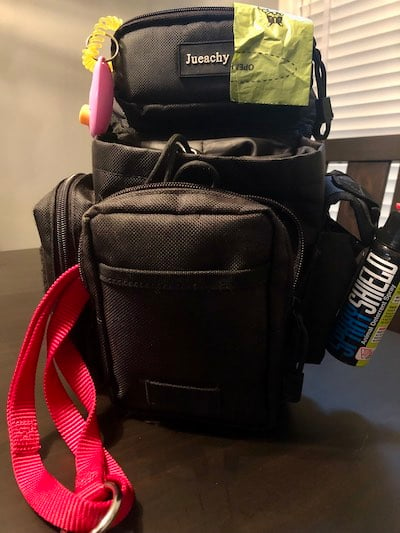
More Resources:
- Webinar: "When Sh*t Hits the Fan: Emergency Defensive Dog Handling with Michael Shikashio and Trish McMillan
- Webinar: Breaking Up a Dog Fight Safely with Trish McMillan
- AggressiveDog.com
Are your dogs fighting at home?
Get the help you need to prevent fights and address the aggression in a one-on-one behavior consult with me.




